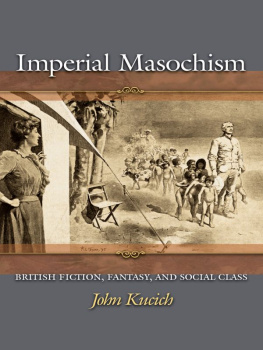Lydia Wilkinson - The five faces of masochism
Here you can read online Lydia Wilkinson - The five faces of masochism full text of the book (entire story) in english for free. Download pdf and epub, get meaning, cover and reviews about this ebook. genre: Romance novel. Description of the work, (preface) as well as reviews are available. Best literature library LitArk.com created for fans of good reading and offers a wide selection of genres:
Romance novel
Science fiction
Adventure
Detective
Science
History
Home and family
Prose
Art
Politics
Computer
Non-fiction
Religion
Business
Children
Humor
Choose a favorite category and find really read worthwhile books. Enjoy immersion in the world of imagination, feel the emotions of the characters or learn something new for yourself, make an fascinating discovery.

- Book:The five faces of masochism
- Author:
- Genre:
- Rating:5 / 5
- Favourites:Add to favourites
- Your mark:
- 100
- 1
- 2
- 3
- 4
- 5
The five faces of masochism: summary, description and annotation
We offer to read an annotation, description, summary or preface (depends on what the author of the book "The five faces of masochism" wrote himself). If you haven't found the necessary information about the book — write in the comments, we will try to find it.
The five faces of masochism — read online for free the complete book (whole text) full work
Below is the text of the book, divided by pages. System saving the place of the last page read, allows you to conveniently read the book "The five faces of masochism" online for free, without having to search again every time where you left off. Put a bookmark, and you can go to the page where you finished reading at any time.
Font size:
Interval:
Bookmark:
Lydia Wilkinson
The five faces of masochism
INTRODUCTION
A work bearing the title of The Five Bloods of Ireland would need no justification for its title other than that the contents of the work deal with the five principal septs or families of Ireland, i.e., the O'Neils, the O'Connors, the O'Briens, the O'Lachlans, and the M'Murroughs; a title of The Five Nations would likewise be as easily justified if the work dealt with the five confederated Indian tribes (the Mohawks, Oneidas, Onondagas, Cayugas, and Senecas), or, as was the case with Rudyard Kipling's volume of poems, if "the five nations" were the five component parts of the British Empire.
Similarly, a title such as The Five Faces of Masochism would, understandably, suggest to the reader that there are but five no more and no less forms or manifestations of that certain peculiar facet of human behavior, or misbehavior, to which Richard von Krafft-Ebing in the latter part of the nineteenth century gave the name of masochism. Such a suggestion, it should be stressed at the very outset of this work, is not intended to be anything other than one of convenience the "masochistic scale" of five simply meaning to reflect the degree or severity of masochistic tendencies and should not be allowed to dominate the reader's thought as anything other than a comparative aid. Suffice it to say that, in the opinion of this author, the majority of people the psychological median, so to speak would probably fall within "masochism one" and "sadism one" range. Somewhere between these two, at "zero", the masochistic and the sadistic inclinations are in a state of equilibrium, or, to put it in other words, are both weak and simultaneously equal, thereby canceling each other out. As one ascends, or descends, the abstract scale in either direction toward "severity five", the misbehavioral aspects of the individual's condition rapidly approach a psychopathological state. A condition of extreme masochism or of extreme sadism "severity five", that is is a relatively rare state of psychosis and is not included in this work. It would not be improper to say that those unfortunate souls who fall within those narrow ranges of psychopathology are seldom available to a private-practice psychiatrist, primarily because "masochist five" is quite often dead, whereas "sadist five" is either in the asylum or is incarcerated.
If one is ready to accept the implication that both masochism and sadism or either the one or the other is present in every individual in "different concentrations", so to speak, then it is an inevitable conclusion that the world is, in fact, made up of the two groups, and the question, then, seems to be not whether one is a masochist or a sadist, or has one or the other inclination, but rather, how much of a masochist or a sadist one is.
Is such a deduction absurd? Not if one studies the history of mankind, and not if one accepts the three definitions of masochism as they are presented by J. P. Chaplin, Professor of Psychology at the University of Vermont and author, in his Dictionary of Psychology. He states that masochism is:
1. a sexual disorder in which the individual derives satisfaction from the infliction of pain upon himself. Pain may be a prelude to, or an accompaniment of sexual relations, or its application may be sufficient in and of itself to induce orgasm.
2. more generally, the enjoyment of suffering or a tendency to seek opportunities for being offended or hurt.
3. (Psychoan.) the turning inward of the destructive tendencies or thanatos.
Chaplin's definition of sadism is, for some reason, less all-encompassing, limiting itself to the sexual side of sadism. He states:
[Sadism is] a sexual perversion in which sexual satisfaction is associated with the infliction of pain.
All one needs to do, however, to complete the picture of the masochism-countering tendency of sadism is to paraphrase Professor Chaplin's definition of masochism. Sadism, then, more generally, may be taken to be "the enjoyment of suffering [in others] or a tendency to seek opportunities for offend[ing] or hurt[ing others]." And, in the terms of psychoanalysis, "the turning [out]ward of the destructive tendencies or thanatos."
It is perfectly natural for an individual to condemn the previous deduction as an "accusation based on generalities": "I have no such tendencies," he might say. The fact is, very few people will seriously admit to having either sadistic or masochistic inclinations either because of society's attitudes toward sadism and masochism, or because they are not aware of, or fail to recognize, either one or the other inclination until they find themselves the subjects of psychoanalysis. Since, quite often, the tendencies toward masochism or toward sadism increase progressively if they go unchecked or unrecognized, the purpose of this work is to show their development and thereby provide the reader with essential defenses against such tendencies through recognition and awareness of them.
Confirming such varying degrees of masochism and sadism is Dr. Eustace Chesser, who in his successful marriage manual Love and the Married Woman writes:
There are varying degrees of sadism and masochism in character traits. The meek, apologetic husband, submitting to a dominant wife, is a mild masochist. Pity is wasted on him, for he deliberately married a woman who would take decisions out of his hands and act the part of a domineering parent. Similarly, the uncomplaining wife who marries a bully may well be reliving her childish experiences with a harsh, authoritarian father. It is dangerous to judge from superficial appearances. Women of a masochistic temperament are best satisfied by so-called virile he-men. This means that the masochist type might do best by marrying a sadist, and vice versa. What passes for cruelty to the casual observer is a curiously inverted pleasure. There are cases in which an ill-treated wife has obtained a divorce for cruelty only to remarry and find herself by her own unconscious wish in precisely the same situation.
Unfortunately, the "solution" that Dr. Chesser presents specifically, that "the masochist type might do best by marrying a sadist, and vice versa" appears to be somewhat of an apathetic oversimplification of sadomasochism in that it does not admit to, or allow for, the previously mentioned "growth and development" of both sadism and masochism. Such a growth and development has to be accepted if one admits to "varying degrees" of either of the two psychopathological states. Naturally, the term growth and development as used herein with reference to sadistic or masochistic character traits connotes a negative side of man's nature. And the negativeness need not be interpreted as such from the society's viewpoint alone; it does not require much thought to realize that in spite of the increasing pleasure, or what a sadist or a masochist interprets as "pleasure" the more masochistic or sadistic a person becomes the closer is he or she approaching an end-all of all pleasure. A masochistic woman who derives pleasure from being taken with some degree of sexual violence will require more and more violence as time goes by and as she becomes accustomed and "immune" to it. Eventually as one or two cases contained within this work will demonstrate she will seek out men who derive pleasure out of brutalizing women, she will develop a craving to be, in fact, raped, abused, forced to perform any number of unnatural acts There is no need in bringing out the well-documented fact that a great number of women who hart been the victims of rape had their mouths sealed by the silence of shallow graves.
Similarly, a man who derives pleasure from deflowering virgins, a man who finds that the screams of his victim add a dimension to his sexual pleasure and thereby magnify the intensity of his orgasm, will strive for attaining a greater reaction to his sexual assault the next time around either by increasing the brutality of his sexual onslaught or, perhaps, by selecting a virgin who will manifest greater screams of pain, i.e., an adolescent virgin, and then a pubescent one, and, finally, a child Again, asylums hold ample evidence of sadists who have, in more ways than one, reached the end of the line.
Font size:
Interval:
Bookmark:
Similar books «The five faces of masochism»
Look at similar books to The five faces of masochism. We have selected literature similar in name and meaning in the hope of providing readers with more options to find new, interesting, not yet read works.
Discussion, reviews of the book The five faces of masochism and just readers' own opinions. Leave your comments, write what you think about the work, its meaning or the main characters. Specify what exactly you liked and what you didn't like, and why you think so.








